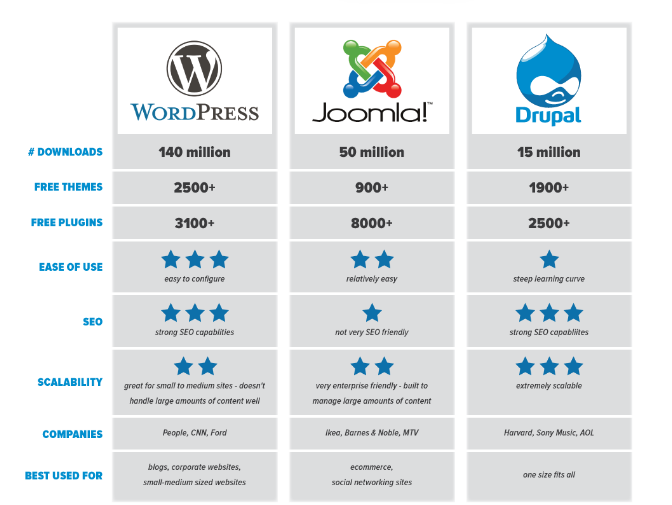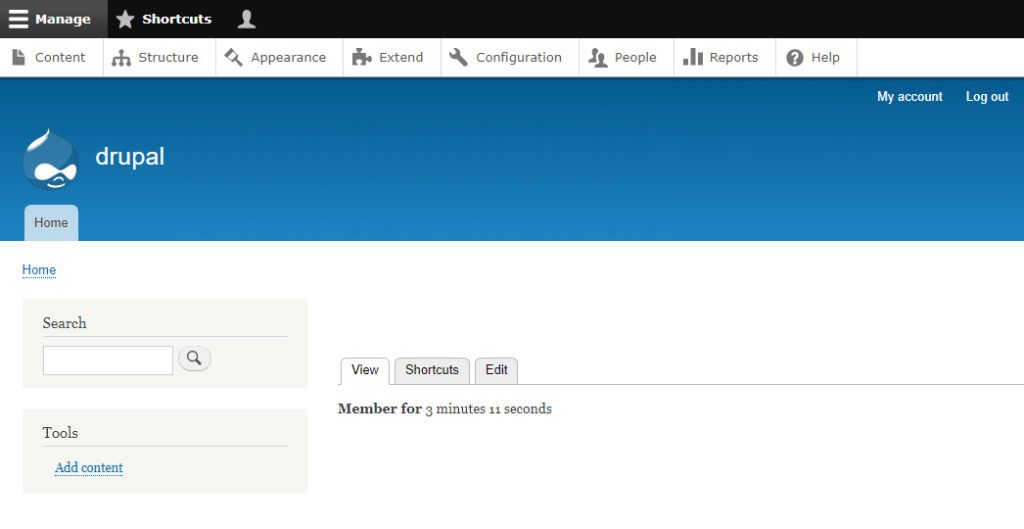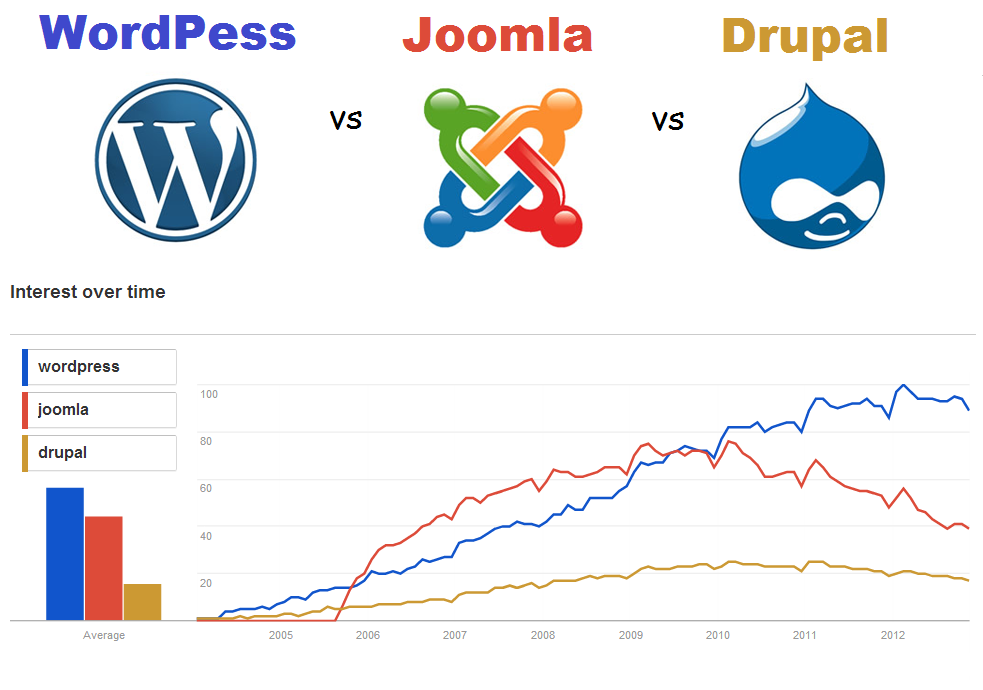What is the difference between Drupal, Joomla, and WordPress? And which open source CMS is best for you and your organization?
Suppose you ask us what the most popular Content Management Systems (CMS) are at the moment. In that case, we answer with conviction: “Joomla, Drupal, and WordPress.” But which of these Open Source CMS is the best?

WordPress
WordPress was started as a Blog System. It is, therefore, also focused on the basic functionalities: placing articles quickly and easily. In just 2 minutes, you have a WordPress online, and you really only have to worry about writing the content.
Open-source WordPress does not have many options from the base, but this is the strength of WordPress. A webmaster who is used to Drupal looks for WordPress options that are not available. A webmaster who is used to WordPress has to get used to Drupal’s many options or settings.
The backend of WordPress
Thanks to the many plugins you can download for your WordPress, you can provide your website with functionality such as forms or overviews. You have to pay for the good plugins, but you usually get support in return.

Matt Mullenweg, the creator of WordPress itself, has a clear vision.
It comes down to less is more.
The addition to WordPress in recent years has not been really shocking or innovative. Also, they are mainly aimed at ease of use.
This has the advantage that WordPress works wonderfully out-of-the-box, and almost anyone can have a nice website set up within a few hours. It is not for nothing that more than 75% of the CMSs on the internet consist of WordPress.
- WordPress is best used for: Blog websites, corporate websites, and magazine websites.
- WordPress is less suitable for: sites where visitors must create an account in which different roles must be linked. (Think of a community website / intranet / extranet / customer portal). The core functionality of WordPress is not extensive enough for this. In practice, you will especially get stuck if you want to give certain role-specific rights. Think of a customer portal where customer X is not allowed to view the invoices of customer Y.
- WordPress is in terms of ease of use: Very easy. Because WordPress does not offer many options from the base, entering, and managing, it is clear. Also, setting up a WordPress website is relatively simple for the developer as long as the editorial staff or owner of the website is not too demanding. The extensive range of plugins, paid or free, offers you the option to expand the website quickly and easily.
Drupal
Drupal is mainly characterized by the many options that are directly present in the system as standard. Think of functionality for defining fields for content yourself or setting up roles for users with their own rights. These are seen as the “core” of Drupal.
The backend of Drupal
Drupal can also be expanded via modules. These work in a different way than the plugins in WordPress or Joomla. Within Drupal, the module is smaller components that integrate with the CMS. The modules are often dependent on other modules, which has the disadvantage of installing quite a lot of modules.

However, due to the strong integration and smaller amount of code, the quality is generally better. The combinations also provide endless possibilities. Compare it with a Duplo and technical Lego. On its own, a technical Lego piece cannot do that much, but when you combine it, a new function is created. That is why Drupal is sometimes seen as a framework because it can do more than a “normal” CMS.
Do you want to know more about the way the Drupal modules work?
In addition to versatility, it is also the stability and scalability that do large businesses. Including Ahold, Utrecht University, Nasa, Holland Casino, RTL Nieuws, or Harvard opt for Drupal. In recent years, the developments of Drupal clearly show that more attention is paid to the needs of these large organizations.

For example, the new version of Drupal, version 8, is completely different in code. In such a way, developers without Drupal knowledge can get in more easily. The aim of Drupal’s creators is to appeal to the higher segment of the web industry, a sector in which websites are often fully customized.
But the strength of Drupal is and remains the versatility of the CMS. As a client, you feel that your website is completely customized and fits exactly with what you need. While the developer can use ready-made modules that integrate well into the CMS. A role for an external editor who only has access to documents in the ‘financial’ category? Or create an overview in which you show products and with filters allow the visitor to select products based on price, weight, category, or name? No problem with Drupal.
- Drupal is best used for: corporate websites, magazine websites, customer portals, community, and intranet websites.
- Drupal is less suitable for: In principle, Drupal can be used for all types of websites. If whoever has to set up the website does not have much experience developing websites, then Drupal, with its many options, maybe too much.
- Drupal is in terms of ease of use: Various. Drupal is extremely easy for those who enter content. Drupal is much better customizable for an editorial team. For someone who needs to build in functionality, Drupal has a steep learning curve. Due to the modular structure, the possibilities are endless, and it takes time before you have enough experience. Consider the technical Lego comparison. You first start with Duplo before you are ready for technical Lego. Unfortunately, we see that a lack of knowledge of Drupal means that people decide too quickly to add custom code or to reprogram an existing module.
Joomla
Started as Mambo in 2000 and later rebranded as Joomla, it runs the longest of the three CMSs. For a long time, the disadvantage of Joomla was that the interface was quite cluttered. Still, with the arrival of Joomla 3, the interface has been overhauled, and it looks a lot clearer and more professional.
The backend of Joomla
Although Joomla was not always experienced as clear, the interface looked very friendly. This has convinced many users to give the system a chance and get to know it better. As a result, Joomla has gathered a large community around it. Despite the strong decline of Joomla websites, there are still many Joomla fans.

Joomla is in no way different from WordPress and Drupal. And that has probably been one of the reasons for the decline in market share. People want a simple CMS (WordPress) that can be set up quickly or an extensive CMS (Drupal) without restrictions. Joomla is actually a bit in between. It may not help either that there is no captain on the ship.
Dries Buytaert rules at Drupal, and Matt Mullenweg is in charge of WordPress. At Joomla, the model is democratic, and the core developers as a group decide what to do. This often leads to a compromise and not always the best solution. An example of this is the updated policy. From Joomla 1.0.x, they went to 1.5.x, then came 1.7.x to be followed by 2.5.x. Not only is there no logic in the version numbers, but each new version had major consequences for website owners. At the same time, substantially little functionality was added to Joomla.
- Joomla is best used for: Corporate website and magazine websites.
- Joomla is less suitable for Websites where visitors must be able to create an account to which different roles must be linked. (Think of a community website / intranet / extranet / customer portal).
- Joomla is in terms of ease of use: Average. The interface looks friendly, but some parts are illogical and require some explanation and getting used to. As a website developer, the learning curve is comparable to that of WordPress.
There is no difference in terms of:
- Web design – The website’s look & feel is determined by the HTML / CSS of the theme or template. The CMS has no influence on this.
- Ease of Use – When it comes to entering articles, the systems are not much different from each other. With all three CMSs, it is possible to use their own WYSIWYG (What You See Is What You Get), editor. The WYSIWYG editor largely determines the ease of use when it comes to placing or editing an article. Common editors are TinyMCE and CKeditor.
- Speed - All three systems are based on the same techniques where caching makes a big difference in the website’s loading time. Since Drupal, Joomla, and WordPress all enable caching (whether via a plugin), there is not much difference in this area.
- Findability – All three systems have more than enough possibilities from the base or via plugins to get the website through an SEO (search engine optimization) ring. Good URLs, page titles, sitemap XML’s or meta tags can be created quite standard in Joomla, Drupal, and WordPress.
Conclusion

When choosing the CMS, consider carefully what functionality is necessary for your website. Do you want a brochure-like website, a simple corporate website, or a blog website? Then WordPress or Joomla are fine systems. Do you want a more extensive corporate website, for example, with a customer portal or an online magazine with more options, such as forms or downloads? Or should users, editors, members, customers, employees be able to log in and be given certain rights or options? Then Drupal is the better choice.
Do you have questions about WordPress, Joomla, or Drupal? Feel free to ask them below in the comment section.
Data analytics expert. As an analyst and project manager, I have proven to be a strong leader and team player in maintaining a suitable workspace for workers and industries in the oil and gas sector.
By taking into account various factors, with the assistance of state of the art technologies and the utilization of Big Data Analytics.
This includes considering various aspects like volume, velocity, variety, veracity, value together with complexity.
With the recent advent of data recording sensors in exploration, drilling, and production operations, oil and gas industry has become a massive data intensive industry.






